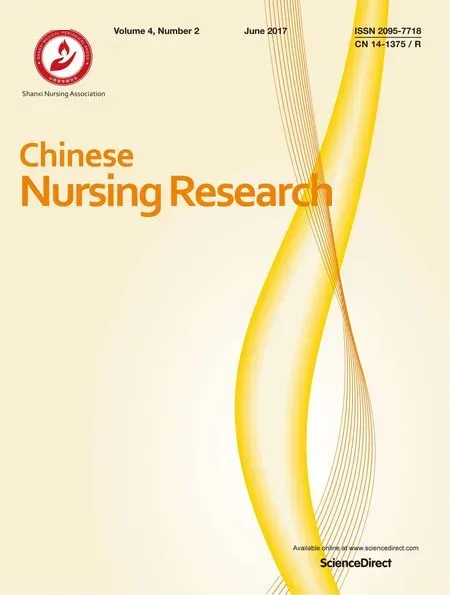A bibliometric study of the Journal of School Health:1965-2014☆
Chi-Chen Zhng,Xio Zheng,Chun-Hui Su,Hung Hung,Feng-Ru Yn, Xio-Jie Pn,Hui-Ning Zho,Zhen-Zhen Jin
aSchool of Management,Shanxi Medical University,Taiyuan,Shanxi 030001,China
bSchool of Public Health,Shanxi Medical University,Taiyuan,Shanxi 030001,China
cYale University,New Haven,CT 06510,USA
A bibliometric study of the Journal of School Health:1965-2014☆
Chi-Chen Zhanga,*,Xiao Zhenga,Chun-Hui Sub,Huang Huangc,Feng-Ru Yana, Xiao-Jie Panb,Hui-Ning Zhaoa,Zhen-Zhen Jina
aSchool of Management,Shanxi Medical University,Taiyuan,Shanxi 030001,China
bSchool of Public Health,Shanxi Medical University,Taiyuan,Shanxi 030001,China
cYale University,New Haven,CT 06510,USA
A R T I C L E I N F O
Article history:
18 February 2017
Accepted 25 March 2017
Available online 8 June 2017
Journal of School Health
Bibliometric
Visualization
Scienti fi c knowledge map
CiteSpaceⅢ
Background:As an important international journal in the fi eld of school health,the Journal of School Health has drawn wide attention from researchers and readers around the world.Therefore,it is important to conduct a systematic retrospective study of the journal.With the aim of understanding the development of the journal and the evolutionary process of cooperative study of this fi eld comprehensively,we employed bibliometric analysis using the articles published in the Journal of School Health from 1965.
Methods:Using bibliometrics,5242 articles published in the journal were extracted and then analyzed using the visualization software CiteSpace III.
Results:The annual published amount of literature showed a declining tendency;however,the frequency of citation displayed an increase year by year.Among proli fi c authors,the number of reports published by JH Price,L Kann and RJ McDermott are at the top.Among the high frequency keywords used in the research journal,“adolescents”,“children”and“programs”have become popular in the journal's vocabulary.CDCP,Univ Texas and Univ Calif are positioned in the forefront of the involved institutions when ranked by degree of contribution.
Conclusions:The Journal of School Health provides an important platform for sharing research achievements and promoting cooperation in this fi eld.The amount of articles published in the journal is continually improving;its cooperative research network promoted by famous scholars and institutions is forming.As more researchers and institutions join,the network will grow and relationships will become increasingly close.However,limitations to cooperation at the regional or interagency scope remain.
©2017 Shanxi Medical Periodical Press.Publishing services by Elsevier B.V.This is an open access article under the CC BY-NC-ND license(http://creativecommons.org/licenses/by-nc-nd/4.0/).
1.Introduction
As a core journal in the Web of Science,the Journal of School Health was fi rst published in 1930,and it has attained an impact factor of 1.659 to date.The major research fi elds that the Journal of School Health concentrates on are Education Scienti fi c Disciplines, Education&Educational Research,Health Care Sciences&Services, and Public Environmental&Occupational Health.The Journal of School Health is published 12 times per year on behalf of theAmerican School Health Association(ASHA).Journal readership includes administrators,educators,nurses,physicians,dentists, psychologists/counselors,social workers,nutritionists/dieticians, and other related health experts.These individuals work cooperatively with parents and social communities to achieve the common goal of providing youths with the programs,services,and environment necessary to promote health and improve learning.Many well-known experts or scholars,taking McDermott et al1-9for instance,have published high quality articles in the journal,which has made great contributions to its development.The Journal of School Health celebrated its 85th anniversary in 2015;based on this, the present article analyzes data informed by the article in this journal,using the information visualization software CiteSpace and the perspective of bibliometrics.Therefore,the aim of this article was to congratulate the journal and provide reference for readers to further understand the journal,as well.
2.Methods
2.1.Data source
In this article,the article was collected from the scienti fi c article database Web of Science.The Retrieval Period is“1965-2014”.The Search Formula is“Publication Name=Journal of School Health”; there were in total 5242 related articles shown after the retrieval. The Retrieval Date was April 30,2014.
2.2.Data processing and analysis
Authors,keywords and institutions were extracted and merged from the 5242 original pieces of data,which meant that multiple words with the same meaning were merged into one relevant word.For example,the keywords“children”and“child”were mergedinto“children”;“cigarette”,“cigarettes”and“tobacco”were merged into“cigarettes”;and“teacher”,“teachers”and“school teachers”were merged into“teachers”.The institutions“Ctr Dis Control&Prevent”,“CTR DIS CONTROL&PREVENT”,“CDCP”and“CTR DIS CONTROL”were merged into“CDCP”;“UNIV CALIF”,“Univ Calif San Diego”,“UNIV CALIF LOS ANGELES”and“Univ Calif Los Angeles”were merged into“Univ Calif”;and“UNIV TEXAS”and“Univ Texas”were merged into“Univ Texas”.In this article,we make a distinction between authors from different institutions but with the same name,for example,JS Greenberg at Univ Maryland was marked as JS Greenberg 1,JS Greenberg at BOSTON UNIV was marked as JS Greenberg 2.Meanwhile,the article uni fi ed the spelling of authors'names,as well,such as L Kann,L KANN and Laura Kann were merged into L Kann;Robert J McDermott and RJ McDermott were merged into RJ McDermott.
2.3.Instruments and procedure
After the data were merged,we drew a knowledge map of the Journal of School Health using the visual software CiteSpace,Vision 3.8.R3,which was researched and developed by professor Chen of Drexel University.10-12CiteSpace is an available Java application intended for visualizing and analyzing trends and patterns in scienti fi c article.Through analyzing and processing scienti fi c article data,CiteSpace could show trends and frontiers in the fi eld of scienti fi c development as a form of knowledge map.This software analyzed the selected relevant nodes according to different criteria, i.e.,authors,keywords and institutions.In this study the analysis period extended from 1965 to 2014 with a time interval of 1 year, from which 49 time slices were formed,displaying the top of the fi gure.The threshold level was set to(2,2,20),(4,3,20),(4,3,20) Top N per slice=50.13-16
3.Results
3.1.Analysis of number of annual published articles
The annual published articles refers to the total number of article about the related subject the journal published each year, and it re fl ects the information content of the journal to some extent.Fig.1 shows the annual distribution of published articles in the Journal of School Health,which was gathered from the Web of Science.From the fi gure,we can see that the annual number of published articles basically presents a declining trend,in which the earlier stage shows a fl uctuation whereas the later stage was relatively stable.The number of annual published articles in 1981 was more than 170,representing the peak of the whole timeline.In addition,the number of annual published articles in the journal can be divided into three stages:the fi rst stage was 1965-1975,during this stage the number of article began increasing,then it reached its maximum in 1970 and began to drop;the second stage was 1976-1988,the amount of article fi rst increased then decreased, reaching the maximum amount for all years in 1981;and the third stage was 1989-2014,during which the amount of article was relatively stable,with a fl uctuation of less than 120 items.As the collected article data's terminal date is April 30,2014,the data statistics for that year are incomplete.
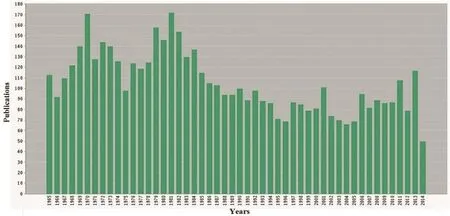
Fig.1.Annual distribution of published articles in the Journal of School Health.
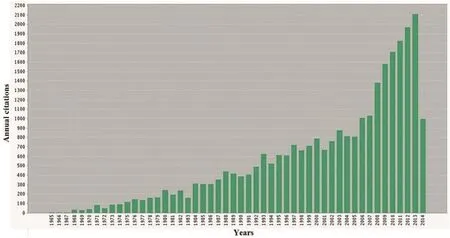
Fig.2.Annual distribution of article citations in the Journal of School Health.
3.2.Analysis of article cited
Fig.2 shows the annual distribution of article citations of the Journal of School Health,which comes from the Web of Science.The citation of article rises continually from 1965.The article's citations increased slowly before 2007 and then increased faster.The same trend applies to the annual published articles of the journal in Fig.1;as the collected article data's terminal date is April 30,2014, the article citations of that year are incomplete.
Table 1 shows the statistical overview of the top 50 articles distributed by year.The total number of citations of the top 50 most cited articles was 4971,with an average of 99.4 citations.In 1989 and 2004,the cumulative number of highly cited articles reached an all-time high(4 for each),and the total number of citations reached its peak,as well(421 times in 1989 and 453 times in 2004, respectively).In 1985,the averagenumberof citations(156.5 times) its peak for the whole timeline.
Because of space restrictions,the top 30 most cited articles are listed in Table 2.The highest number of citations of a single article appeared in 1989,when cumulative frequency reached 188 for an article which was titled“Essential elements of school-based smoking prevention programs”and was written by TJ Glynn.The second-highest cited article was DB Connell's“Summary of fi ndings oftheschool-healtheducationevaluation-healthpromotion effectiveness,implementation,and costs”.The third was“Promoting school connectedness:Evidence from the national longitudinal study of adolescent health”,written by CA McNeely.
3.3.Analysis of authors'cooperation network
We selected authors as the network node for analysis;there are altogether 1931 nodes,correlated with 711 connecting lines.Fig.3 shows the cooperative relationship among authors based on the threshold level.Each node represents an author,and the circle size demonstrates the amount of article published by each author.The circle's color represents the publication year of the article in question.The connecting lines between the circles display direct or indirect cooperation between different nodes,and their color represents the fi rst yearof cooperation.17,18There are two typical teams that cooperated closely and published more article than all other authors.One is a large cooperative team with a complex organization of scienti fi c research,comprising JH Price,SK Telljohann,NDBrener,LJ Kolbe,JG Ross,RS Gold,RJ McDermott,etc.Membership of this team was intensive,and there was a wide network allowing close cooperation between each member.The total amount of published article produced by this group topped the list,as well. This suggests that the team played an important role in the Journal of School Health with a high volume of contribution.The members of the other team included TW Orourke,RM Pigg,MR Torabi,DL Kerr,etc.The number of members of this teamwas relatively larger, and the cooperation between authors was also comparatively closer.
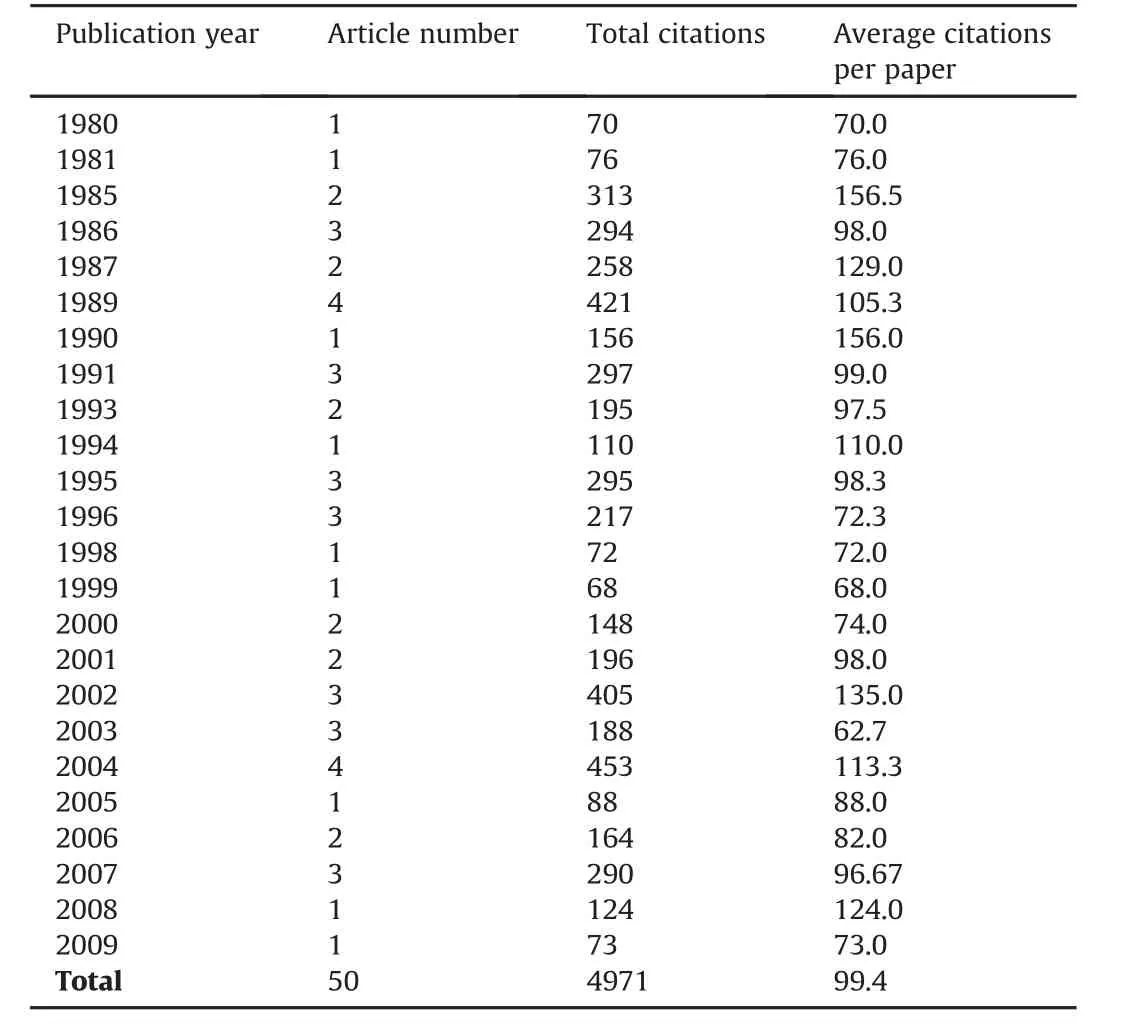
Table 1 Annual distribution of the top 50 cited publications and their citations in the Journal of School Health.
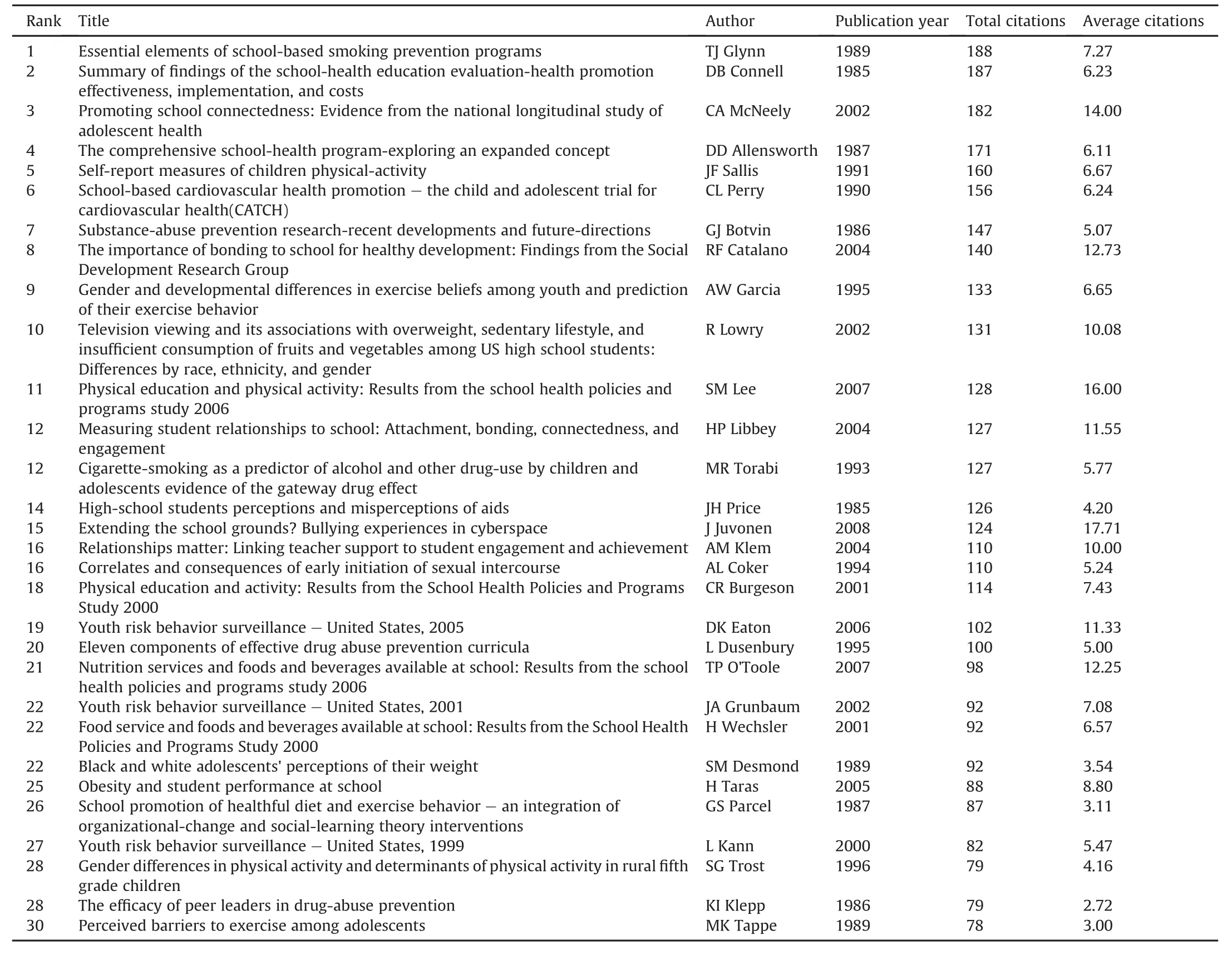
Table 2 Top 30 cited publications and their information in the Journal of School Health.
The frequency of an author re fl ects the number of pieces of published article he/she participated in.This frequency includes various author orders,for example,the fi rst author,the second author and corresponding author.Due to space restrictions,27 authors whose frequency was≥15 were listed inTable 3.It is worth paying attention tothe existence of a big limitation on the degree of centrality held byeach author in the whole cooperative network.In this study,there were 5242 articles published which involved 4468 authors,indicating an average of 1.17 articles per author.Scholars JH Price,L Kann and RJ McDermott are at the top of the list in terms of the number of articles published.The initial publishing year of the articles that had a frequency≥15 was 1985 on average.
3.4.Analysis of high frequency keywords and their co-occurrence network
Keywords were selected as the network nodes for analysis. There are 410 nodes and 1014 connecting lines in total.This suggests a high frequency of the co-occurrence of related keywords.An author's research focus in this fi eld can be found through keyword analysis.Fig.4 shows the relational network between keywords.To clearly render the relationships of co-occurrence between keywords,Fig.4 shows the high-frequency keywords whose frequency≥28.The keywords“adolescents”and“children”are found in the center of the map,and form connecting lines with other keywords in a complicated and intensive manner.The high-frequency keywords can be divided into 4 classes:research objects such as“adolescents”,“children”and“health”;behaviors and in fl uencing factors such as“behaviors”,“obesity”and“smoking”;intervening measures like“physical activity”,“education”and“prevention”for instance;and other aspects such as“prevalence”,“impact”and“population”.Furthermore,there is only one country,“unitedstates”,shown in the fi gure,which means that the United States is highly active in the Journal of School Health.School health in the United States is becoming a research hot spot.
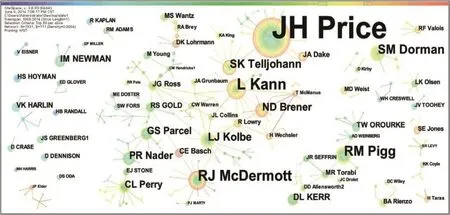
Fig.3.Cooperation network map of high frequency authors in the Journal of School Health.
Table 4 lists the keywords that have a frequency≥50,after being catalogued.Combining Table 4 with Fig.4,we can conclude that the frequency of“adolescents”tops the list,appearing as many as 429 times.Keywords“children”,“programs”,“health”and“behaviors”are at the forefront of high-frequency keywords,as well.
3.5.Co-occurrence network analysis of the institutions
Institutions were selected as network nodes for analysis.There are altogether 1268 nodes and 459 connecting lines according tothe statistical results produced by CiteSpace III.Due to space restrictions,institutions with a frequency≥10 were selected as network nodes to produce the visual map of institutions'cooperation,as seen in Fig.5.It shows close cooperation among the selected institutions,based on the arrangement and condition of the connecting lines.The legend color represents the research fi eld in which the institutions were involved at different stages(early phase,mid phase and recent period).The study produced by the most institutions presents a consecutive approach from the early phase to recent period.In this study,it is possible that there are articles that contain several authors who may belong to the same institution or a single author who has published several articles as a member of the same institution.In addition,given that the same author might work at different institutions during different times, institutional frequency would be different from the number of institution members who have participated in research.Therefore, institutional frequency cannot re fl ect an institution's research strength accurately enough,but it can be deemed an evaluation of the creativity of the researchers belonging to related institution in the fi eld of school health.19
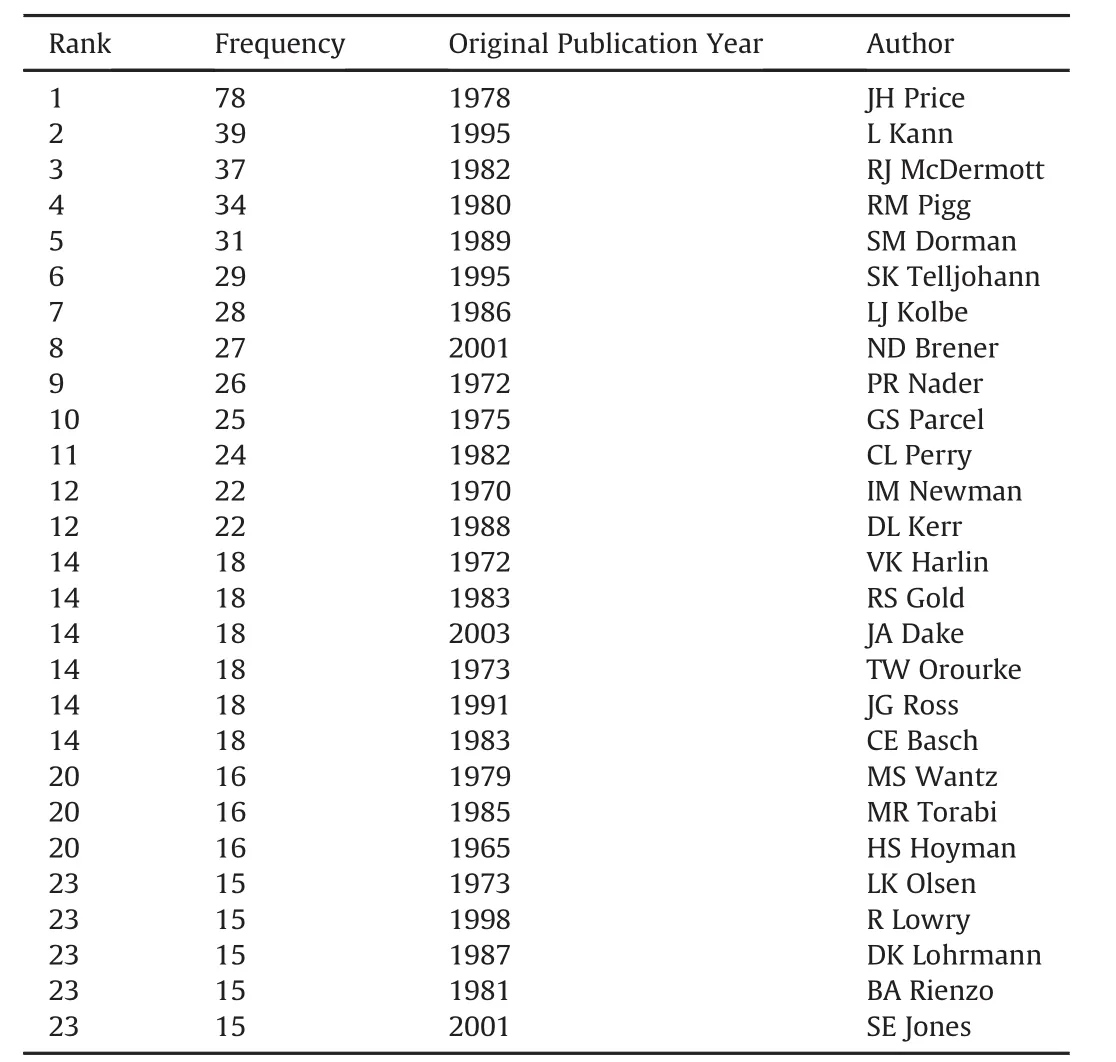
Table 3 Authors with published articles that occur≥15 times in the Journal of School Health.
Given the large variety in the names of institutions,this study integrated the names of institutions to systemically show the contributions of institutions directly and clearly.Table 5 shows the top 10 institutions sorted by the amount of article they have published after classi fi ed integration.The amount of published article from CDCP tops the list,and its research on school health was also conducted earlier.The second-ranked institution is Univ Texas,with a frequency of 96.The third is Univ Calif,with a total frequency of 87.
3.6.Visualization analysis of country cooperation
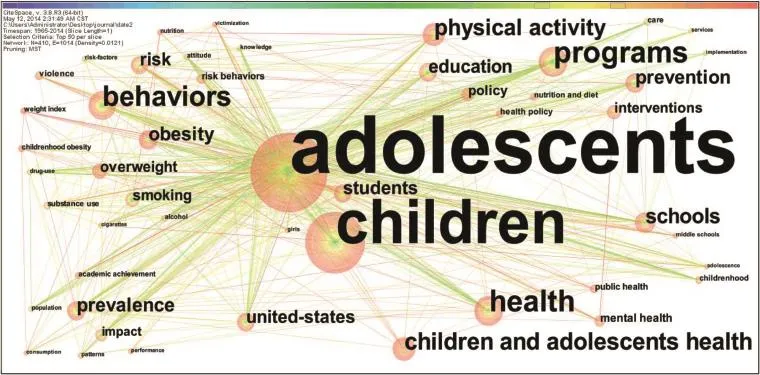
Fig.4.Network map of keyword co-occurrence in the Journal of School Health.
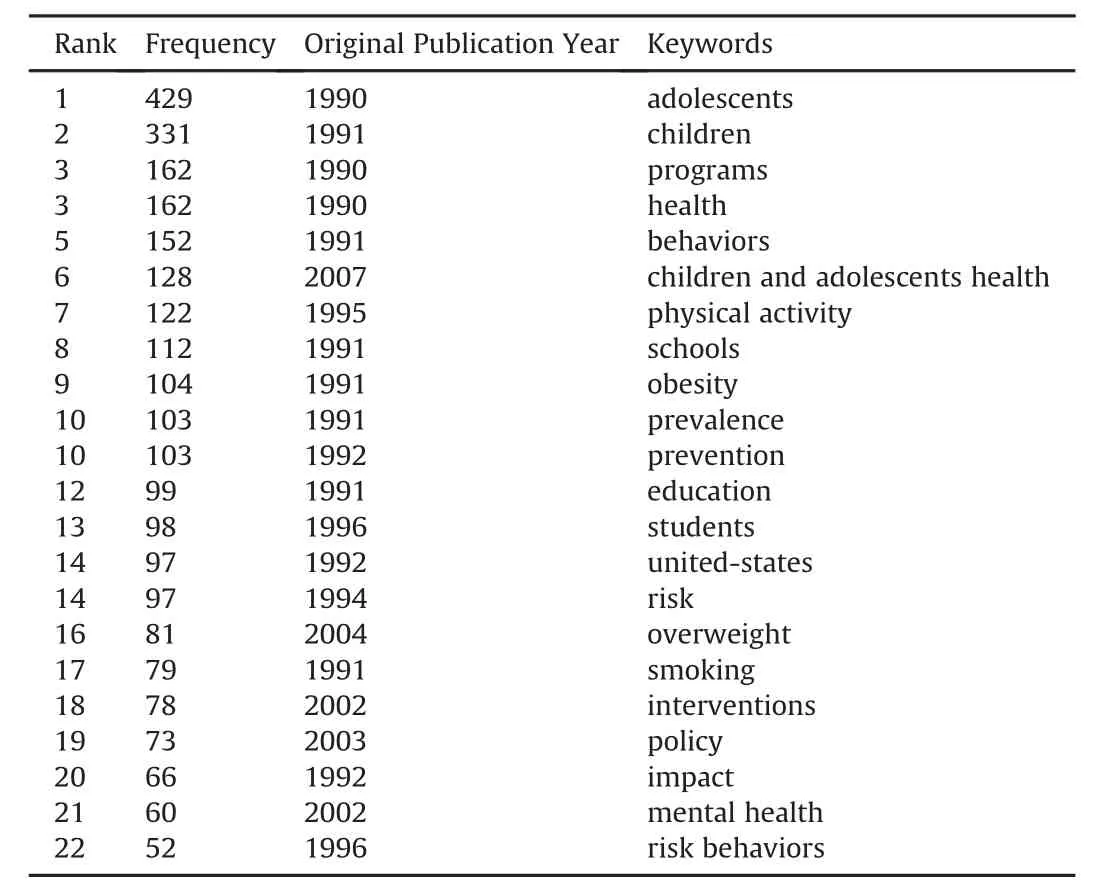
Table 4 Keywords that occur≥50 times in the Journal of School Health.
Though analyzing the distribution of research achievements across countries,it is possible to understand the regional distribution of research power related to a certain subject area,which could help people to understand the contributions of a region/ country to this research area.Fig.6 shows the countries with the highest levels of contribution and their cooperation with other countries among the 44 countries that participate in the creation of such research.Table 6 lists the countries and districts that produced an amount of published article≥6.Considering the fi gure and table together,we can see that the United States is the country that has made the biggest contribution,having published 3128 articles.Following the United States are Canada and Australia;the centrality of Australia is 0.02.Compared with institutions and authors,scienti fi c research cooperation between countries is relatively limited.Cooperative relationships occur with a low degree of frequency and only between a few countries;cooperation is also mainly concentrated in the recent period.
4.Discussion
The Journal of School Health is committed to providing an information communication platform for schools and their related staff,with an aim of promoting the health growth of adolescents and of building a healthy environment for school development.The journal mainly takes students as the objects of study to facilitate corresponding research from different perspectives,such as the promotion of health education,physical education,health services, nutrition services,counseling services,and family/community involvement.
The evolution of the number of annual published articles in the Journal of School Health since its inaugural editorial can be divided into three stages.The amount of published article in the fi rst two stages increased at fi rst,and then decreased,reaching its maximum in 1981 at more than 170 articles.The amount of published article fl uctuatedbetween70and120after asigni fi cantdecline. Compared with the number of annual published article,the annual number of citations of the journal's article was generally on the rise throughout the whole timeline,and the volume citations underwent a dramatic increase after 2007.The decreasing number of publications followed by an increase in citation frequency suggests that the journal is switching its focus from the quantity of publication to the quality of each single article.With improvementof the quality of journal articles,the in fl uence of the journal has enhanced,as re fl ected by the impact factor's elevation from 1.495 to 1.659.Furthermore,12 articles of the 30 top cited articles involved the study of adolescents'physical activity,nutrition and diet.Aside from these,there were 5 articles about smoking and substance abuse.The other 5 articles focused on the theme of the role of schools in students'health.Obviously,adolescent behavior problems became the most prevalent current research area in the Journal of School Health.
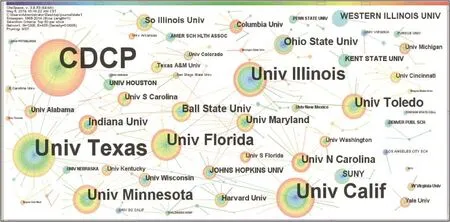
Fig.5.Cooperative research network visualization map of institutions in the Journal of School Health.
By analyzing cooperation among authors,one could identify the core scholars and their related research teams,as well as their relationships.20,21As shown in Fig.3,among authors with high productivity,scholar HS Hoyman with his classic work“An ecologic view of health-education”began to publish relevant scienti fi c research achievements starting in 1965.In addition,VK Harlin,IM Newman,WH Harris and PR Nader published work in the same period as HS Hoyman.They also formed their own scienti fi c research teams in the early phase and laid a good foundation for the development of the school health fi eld.Afterwards,the scholars JH Price,CL Perry,RJ McDermott and RM Pigg started to gradually become involved in the research of the school health fi eld.As a result,series of long lasting,broad and highly active works were published,whichled tofurther stable developmentof the studies in this fi eld.In time,a growing number of excellent scholars such as ND Brener,H Wechsler and JA Dake have joined the research of school health,which promotes the introduction of novel notions into this area of research and facilitates the steady development of the fi eld with scholars in the early phase.
From the perspective of the cooperative relationships between researchers,with the deepening of research work,authors'cooperative relationships with the Journal of School Health are becoming closer,and scienti fi c research cooperation networks are extending gradually.Based on the research teams represented by PR Nader,GS Parcel,RS Gold,RJ McDermott,LJ Kolbe,and DK Lohrmann,ascienti fi c research chain was formed in the early-to-mid period of the Journal of School Health through direct or indirect contact.From the inspiration provided by the early-to-mid phase authors such as RJ McDermott and LJ Kolbe,new authors i.e.,R Lowry,ND Brener,L Kann,and SK Telljohann,started to connect themselves into this network in a direct or indirect way.Thus far,the complex and close scienti fi c research cooperation network is formed in the Journal of School Health through the merging of the scienti fi c research teams in the early-to-mid period and the recent period.
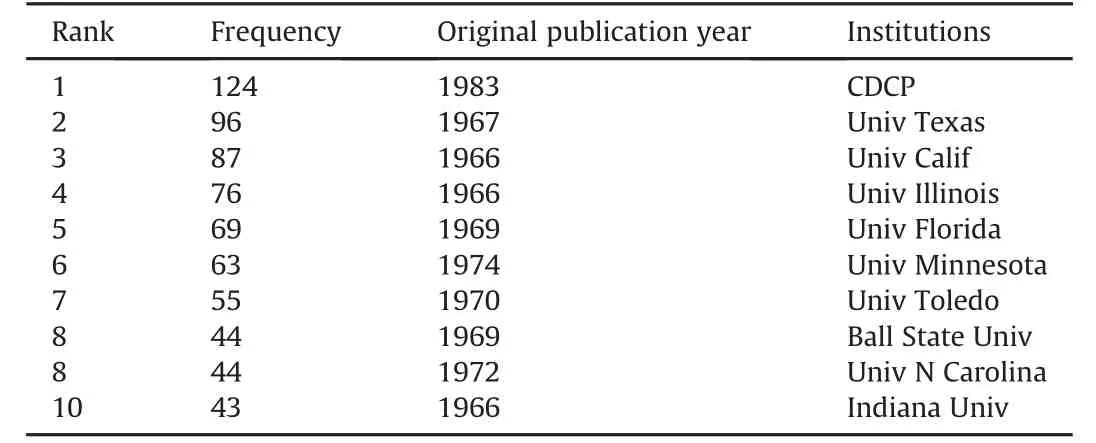
Table 5 Top 10 institutions with published article in the Journal of School Health.
To some extent,the frequency of keywords can re fl ect the research focuses of published articles in the Journal of School Health and provide reference for researchers and policy makers.22,23Cooccurrence of keywords with a close connection in this journal usually happens.Keywords such as“adolescents”and“children”are at the top of all others in terms of frequency.This illustrates that the objects of studies are usuallyconcentrated on student groups at school,especially female students.Meanwhile,the study of this kind of object mainly focuses on their health condition(mental health),performance and factors that in fl uence adolescence and childhood.In terms of behaviors and in fl uence factors,the study emphasizes smoking,violence and substance abuse.Alongside those dangerous behaviors,obesity and overweightness are the most important factors that affect the health of students and children.Examiningintervention methods,besidesconventional nursing care,prevention and health policy,some mature methods, such as health education,physical activity,nutrition and diet have become hot spots.In addition,the Journal of School Health has also studied the demographic features of schools'academic achievement.It should be noted that the United States is the only countrylike word within the high frequency keywords.This suggests that the article published in the Journal of School Health not only contains extensive and in-depth study of the school health of Americans but also has certain relationships with journal language and research origin.
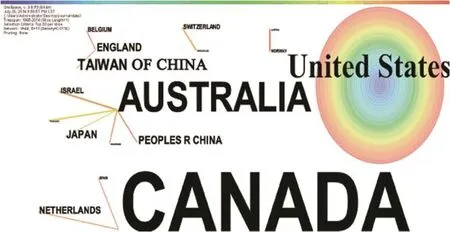
Fig.6.Cooperative research network visualization map of countries in the Journal of School Health.

Table 6 Top countries and districts with≥6 published articles in the Journal of School Health.
Through the visual analysis of the cooperation between institutions and countries,we can understand the contributions to the journal offered by each institution,country or district and the intercommunication between these entities.24,25By combining Fig.5 with Table 5,it can be found that the institutions,such as CDCP,Univ Texas,Univ Calif,Univ Illinois,Univ Florida and Univ Minnesota were responsible for a large amount of the publications, and they contributed a large part of the journal.This suggests that most of the researchers from those institutions have joined into school health research work.Further analysis found that high contribution institutions are usually major universities,which are the main force behind article publishing.Meanwhile,a certain level of relevance was indicated between the amount of the publications produced by an institution and its economic and technological development levels.The institutions with a high amount of published article are mainly located in the eastern United-states, especially the Great Lakes region,and on the west coast where economyand technologyare highly developed;these regions host a high density of scienti fi c research colleges and universities.Additionally,not only is there cooperation between institutions located in the same states,such as the cooperation of Univ Florida and Univ S Florida in Florida,but there is also interstate cooperation,such as the cooperation of Univ Texas in Texas and Univ Minnesota in Minnesota.International cooperation between institutions is still limited,even though cooperation among institutions is relatively close.This phenomenon also re fl ects the fact that school health research has a certain regional imbalance.
5.Limitations
As our source of data,the Web of Science serves the purposes of this study due to its wide recognition by the scienti fi c community and its ability to accurately re fl ect the general situation and trends in the development of the Journal of School Health. However,due to the required database permissions and the functional limitations of CiteSpace,use of Web of Science might lead to partial descriptions of cooperative relationships that are not comprehensive,which would affect the adequacy of this study.
6.Conclusions
The Journal of School Health has experienced rapid development since 1930,when it was fi rst published.As one of the international journals in this fi eld,the Journal of School Health has drawn wide attention from researchers in the fi eld of school health,which focuses on addressing the practice,theory,and research related to the health and well-being of school-aged youth.Under the direction of the current editor-in-chief RJ. McDermott,the Journal of School Health continually meets the needs of different readers such as administrators,counselors, dentists,health educators,physical educators,school nurses and school physicians.At the same time,the journal is developingtowards a higher level and providing an important platform to promote the deepening of research.From the perspective of the article published in the journal,research in this fi eld is showing a steady trend of development,and a wide network of scienti fi c research cooperation has gradually formed,although international cooperation is still relatively limited.We strongly expect the Journal of School Health to become a platform for information exchange and display of achievements for researchers and readers in the fi eld of global school health and to further promote scienti fi c research cooperation and communication between different institutions and regions,to further enhance the comprehension and development of the study of the theory and practice of school health.
Con fl icts of interest
All contributing authors declare no con fl icts of interest.
1.McDermott RJ.Leadership for school health:more important now than ever. J Sch Health.2012;82:1-2.
2.Oberne A,McDermott RJ.How many steps does it take to put on a condom?-A commentary.J Sch Health.2010;80:211-213.
3.Bryant CA,Courtney AH,McDermott RJ,et al.Promoting physical activity among youth through community-based prevention marketing.J Sch Health. 2010;80:214-224.
4.Price JH,Rickard M.SCHIP directors'perception of schools assisting students in obtaining public health insurance.J Sch Health.2009;79:326-332.
5.Khubchandani J,Telljohann SK,Price JH,Dake JA,Hendershot C.Providing assistance to the victims of adolescent dating violence:a national assessment of school nurses'practices.J Sch Health.2013;83:127-136.
6.Rickard ML,Price JH,Telljohann SK,Dake JA,Fink BN.School superintendents' perceptions of schools assisting students in obtaining public health insurance. J Sch Health.2011;81:756-763.
7.Eaton DK,Brener ND,Kann L,et al.Computer availability and principals'perceptions of online surveys.J Sch Health.2011;81:365-373.
8.Kann L,Brener ND,Wechsler H.Overview and summary:school health policies and programs study 2006.J Sch Health.2007;77:385-397.
9.Brener ND,McManus T,Wechsler H,Kann L.Trends in professional development for and collaboration by health education teachers-41 states,2000-2010. J Sch Health.2013;83:734-742.
10.Chen CM.CiteSpace II:detecting and visualizing emerging trends and transient patterns in scienti fi c literature.J Am Soc Inf Sci Technol.2006;57:359-377.
11.Chen C,Hu Z,Liu S,Tseng H.Emerging trends in regenerative medicine:a scientometric analysis in CiteSpace.Expert Opin Biol Ther.2012;12:593-608.
12.Kliegl R,Bates D.International collaboration in psychology is on the rise.Scientometrics.2011;87:149-158.
13.Toivanen H,Ponomariov B.African regional innovation systems:bibliometric analysisofresearchcollaborationpatterns2005-2009.Scientometrics. 2011;88:471-493.
14.Oliveira M,Gama J.An overview of social network analysis.Wiley Interdiscip Rev Data Min Knowl Discov.2012;2:99-115.
15.Uddin S,Hossain L,Abbasi A,Rasmussen K.Trend and ef fi ciency analysis of coauthorship network.Scientometrics.2012;90:687-699.
16.Kronegger L,Mali F,Ferligoj A,Doreian P.Collaboration structures in Slovenian scienti fi c communities.Scientometrics.2012;90:631-647.
17.Abt HA.The frequencies of multinational papers in various sciences.Scientometrics.2007;72:105-115.
18.Lee B,Kwon O,Kim HJ.Identi fi cation of dependency patterns in research collaboration environments through cluster analysis.J Inf Sci.2011;37:67-85.
19.Zhang CC,Duan ZG,Yu Q,Tong L,Geng YX.CiteSpace II-based information visualization analysis for Chinese Journal of Health Management.Chin J Health Manag.2012;6:306-310(in Chinese).
20.Yu Q,Shao HF,Duan ZG.Research groups of oncology co-authorship network in China.Scientometrics.2011;89:553-567.
21.Zhang CC,Yu Q,Fan QH,Duan ZG.Research collaboration in health management research communities.BMC Med Inform Decis Mak.2013;13:52.
22.Hayati Z,Didegah F.International scienti fi c collaboration among Iranian researchers during 1998-2007.Libr Hi Tech.2010;28:433-466.
23.Zitt M,Bassecoulard E,Okubo Y.Shadows of the past in international cooperation:collaboration pro fi les of the top fi ve producers of science.Scientometrics.2000;47:627-657.
24.Liu GY,Hu JM,Wang HL.A co-word analysis of digital library fi eld in China. Scientometrics.2012;91:203-217.
25.Zhao LM,Zhang QP.Mapping knowledge domains of Chinese digital library research output,1994-2010.Scientometrics.2011;89:51-87.
How to cite this article:Zhang C-C,Zheng X,Su C-H,et al.A bibliometric study of the Journal of School Health:1965-2014. ChinNursRes.2017;4:75-83.http://dx.doi.org/10.1016/ j.cnre.2017.03.011
5 January 2017
☆The study was supported and funded by MOE(Ministry of Education,China), the research projects of Humanities and Social Sciences(No.13YJCZH239)and the National Natural Science Foundation of China(No.71403155).It is also supported by Shanxi Federation of Social Science Circles(No.SSKLZDKT2014084).
*Corresponding author.
E-mail address:zhangchichen@sina.com(C.-C.Zhang).
Peer review under responsibility of Shanxi Medical Periodical Press.
in revised form
- Frontiers of Nursing的其它文章
- Transitional care interventions to reduce readmission in patients with chronic obstructive pulmonary disease:A meta-analysis of randomized controlled trials
- In fl uence of mobile education on joint function and quality of life in patients after total hip arthroplasty☆
- Development of a frailty scale for elderly people in China☆
- How to establish an expected animal model of post-traumatic osteoarthritis?
- Chewing gum for postoperative ileus after colorectal surgery: A systematic review of overlapping meta-analyses
- Retraction notice to“Relationships between perceived social support and retention patients receiving methadone maintenance treatment in China mainland”[CNR 3/1(2016)11-15]

